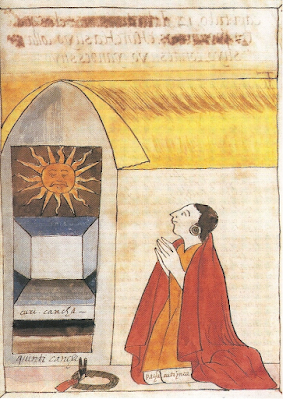 |
| Threatening Rock at the Chaco Canyon complex, standing over the origin of the world. |
Is it the most decisive paradox of our time, that power legitimates itself by promising existential security while producing 'material' insecurity? The political philsopher Paolo Virno writes that humans are the animal who is permanently disoriented in the world (2004), and thus lacks any specialised insticts with which we can orient ourselves. Foucault, in his lectures Security, Territory, Population (1978), showed how security is not simply protection but a way of governing through uncertainty: states and institutions produce insecurity — scarcity, crisis, risk — precisely to justify new interventions. Power appears to secure, but in fact thrives on keeping things perpetually insecure. Zygmunt Bauman, in Liquid Fear (2006), develops this argument by showing how modern societies manufacture diffuse insecurities — precarity, ecological collapse, financial instability — while offering only illusory securities in the form of gated communities, consumer lifestyles, or nationalist identities. People trade away material security for symbolic belonging: better to be precarious but certain of who one is, than materially stable but existentially uncertain.
Anthony Giddens, in Modernity and Self-Identity (1991) develops the concept of ontological security, defined as the confidence people have in the continuity of their self-identity and the constancy of their environment. When this continuity is threatened, people cling to routines, institutions, or leaders that feel stable, even if those leaders undermine their material well-being. This helps explain why people sometimes vote against their own economic interests: existential security, the sense of being grounded in a coherent world, takes precedence over material security. Judith Butler, in Precarious Life (2004), adds that vulnerability is shared by all, but societies politicize it by deciding whose lives are secured and whose are rendered disposable. People may accept austerity, war, or insecurity because they are promised recognition, belonging, or moral certainty.
From a more existential angle, Ernest Becker’s Denial of Death (1973) argues that humans accept destructive systems because they provide symbolic immortality — nations, religions, or identities that outlive individual mortality. Ernesto de Martino, in Il mondo magico (1948) and La fine del mondo (1977), likewise argued that human beings constantly risk losing their “presence,” their ability to orient themselves meaningfully in the world. Rituals and myths act as “technologies of presence,” restoring existential security in the face of ecological catastrophe or cultural breakdown. Communities may therefore accept arrangements that exploit their material base if those arrangements preserve symbolic order and restore presence. Paolo Virno, in Grammar of the Multitude (2004), reworks Kant’s concept of the sublime to argue that existential insecurity is a permanent condition of modern life. Neoliberalism exploits this insecurity as precarity, but at the same time it can produce creativity, solidarity, and common life.
Karl Polanyi’s The Great Transformation (1944) offers a political-economic perspective, showing how capitalism generates insecurity by commodifying land, labor, and money, yet populations often support these regimes because they are promised modernization, national identity, or moral order. Anthropologists have echoed this. James Ferguson, in The Anti-Politics Machine (1990), shows how development projects worsen material insecurity but succeed by offering recognition as “modern” citizens. Arjun Appadurai, in Fear of Small Numbers (2006), explores how existential fear of being out of place leads people to embrace violent politics that undermine their material conditions while reaffirming belonging. Didier Fassin, in Enforcing Order (2013), demonstrates how policing creates insecurity for migrants and the poor, yet is broadly supported because it symbolizes order.
Taken together, these thinkers converge on a common insight. Security is never just about resources, finances, or survival: it is also about identity, recognition, and existential grounding. People are often willing to accept — even demand — systems and leaders that undermine their material well-being if those systems promise to resolve the more frightening possibility of existential disorientation. Being lost and meaningless can feel more terrifying than being poor or precarious. Thus, existential security becomes the real currency of politics: people trade away sustenance for the assurance of belonging, stability, and presence. Power, in turn, thrives on this paradox, promising to secure life while continually producing the insecurities that keep populations dependent on its order.










